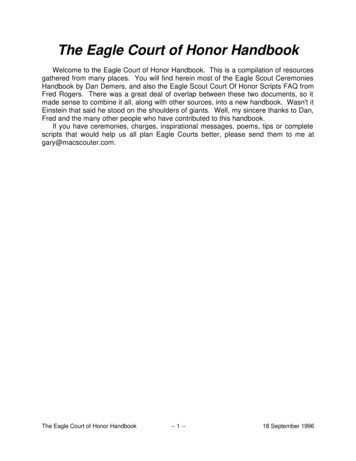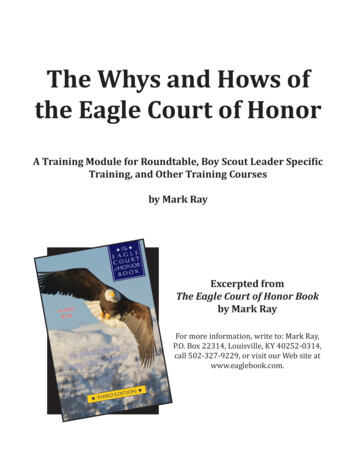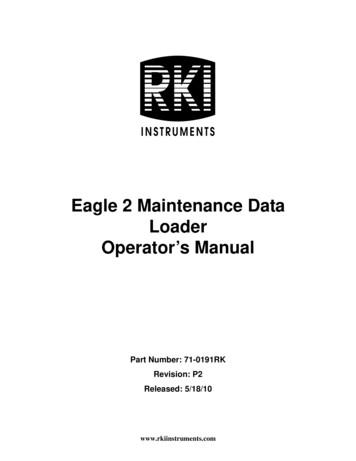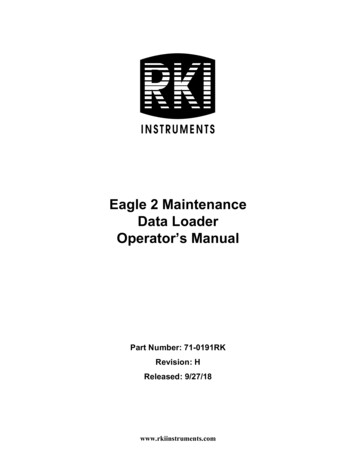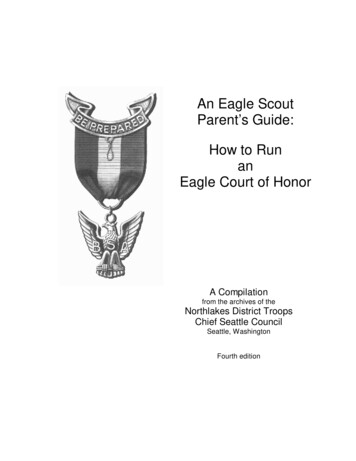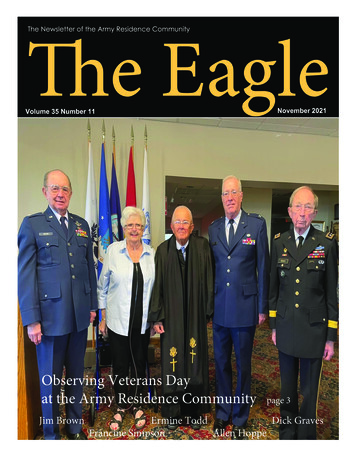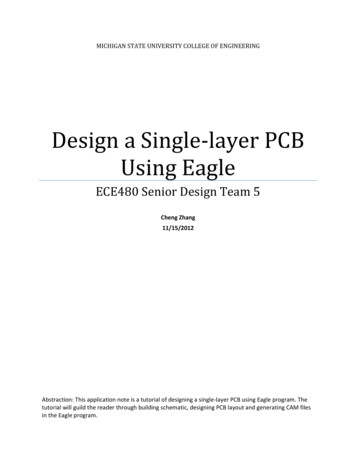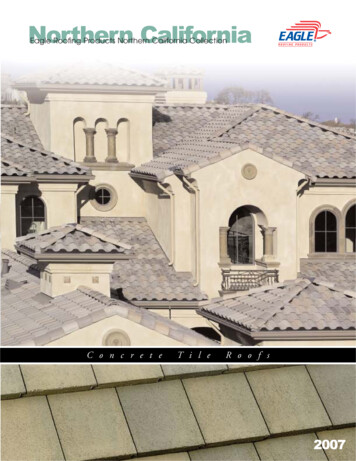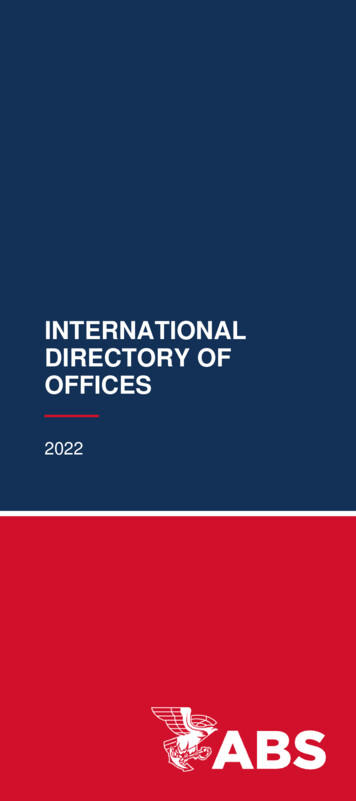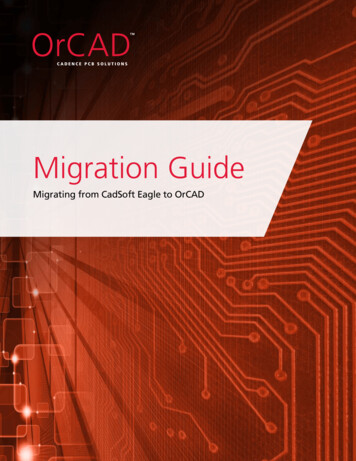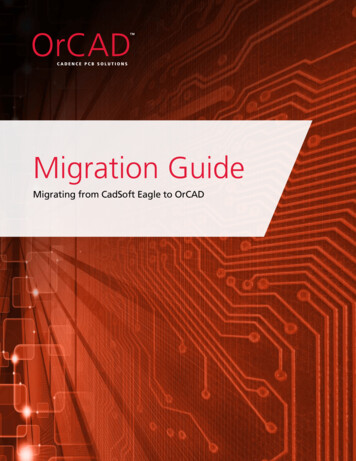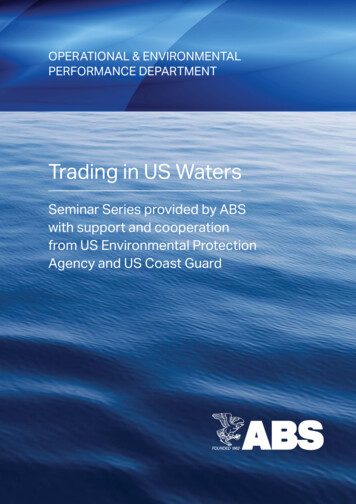
Transcription
OPERATIONAL & ENVIRONMENTALPERFORMANCE DEPARTMENTTrading in US WatersSeminar Series provided by ABSwith support and cooperationfrom US Environmental ProtectionAgency and US Coast Guard
Our MissionThe mission of ABS is to serve the public interest as well as theneeds of our members and clients by promoting the security oflife and property and preserving the natural environment.Health, Safety, Quality &Environmental PolicyWe will respond to the needs of our members and clients and thepublic by delivering quality service in support of our Mission thatprovides for the safety of life and property and the preservationof the marine environment.We are committed to continually improving the effectiveness ofour health, safety, quality and environmental (HSQE) performanceand management system with the goal of preventing injury, illhealth and pollution.We will comply with all applicable legal requirements as well asany additional requirements ABS subscribes to which relate toHSQE aspects, objectives and targets.
Table of Contents1. Introduction .12. The Seminars .23. Questions & Answers .3General Questions .3Ballast Water Management (BWM) – General.4BWM – Deadlines and Compliance .7BWM – USCG Extensions .9USCG – BWMS Type Approvals . 11USCG – General Questions . 14Vessel General Permit (VGP) – General Information . 14VGP – Discharge Specific Questions . 15Trading in US Waters December 2014 Page i
VGP – Oil-to-Sea Interfaces . 16VGP – Reporting and Inspections .18VGP – Sampling and Monitoring.19Air Emissions – General .20Air Emissions – Low Sulfur Fuel .21Other Questions .244. Seminar Participants.25Page ii Trading in US Waters December 2014
1. IntroductionThe Trading in US Waters seminars were developed to address questions concerning theimplementation of recent and upcoming environmental regulations in the United States(US). Areas of interest and concern included the US Coast Guard (USCG) ballast watermanagement regulations, compliance with North American Emissions Control Area (ECA)and the US Environmental Protection Agency’s (EPA) 2013 Vessel General Permit (VGP).Seminars were organized by the Operational and Environmental Performance (OEP) teamwith collaboration and assistance from local ABS management and Technology andBusiness Development Directors (TBDs). The December 2014 seminars were held in threelocations: Athens, Genève and Hamburg. These seminars attracted over 400 shipowners,ship operators and technical managers interested in achieving a better understanding ofthe requirements and compliance strategies to trade in US waters.A major element of these seminars was the participation of speakers from the USCG and USEPA, which enhanced the credibility and relevance of the seminars. ABS was honored thatCDR Ryan Allain, USCG – Washington, DC and Mr. Marcus Zobrist, US EPA – Washington, DCwere able to participate in the seminars. The USCG and EPA appreciated the opportunity toprovide information to the industry via these venues.ABS also invited local shipowner organizations to present information on topics ofsignificant interest. In Athens, the Marine Technical Managers Association (MARTECMA)and Maran Gas Maritime provided presentations. In Hamburg, the Verband DeutscherReeder (VDR) (German Shipowners’ Association) discussed regulations impacting theshipping community.Time was also allotted to respond directly to questions from participants. The questionand answer sessions covered many areas. The purpose of this document is to provideparticipants written documentation of questions answered and address questions thatcould not be answered due to time constraints. The primary goal of addressing concernsraised by vessel owners and operators was achieved.The feedback from attendees was very positive. Attendees commented that theinformation was relevant and timely and will help shipowners ensure vessels areoperating in compliance in US waters.Trading in US Waters December 2014 Page 1
2. The SeminarsAs previously stated, the seminars were held in three locations with over 400 attendees from250 companies. The seminar agendas in each location were the same with some adjustmentsto account for time constraints. The general seminar agenda was:Welcome & Introduction – Local ABS managementABS Asset Performance Management Overview – Mr. Howard Fireman, ABS,Senior Vice President, Asset Performance ManagementUSCG Ballast Water Management Regulations – CDR Ryan Allain, USCG Washington, DC,Chief, Environmental Standards Division2013 VGP – Mr. Marcus Zobrist, US EPA Washington, DC, Chief, Industrial BranchAir Emission Concerns & Compliance Strategies – Mr. Stamatis Fradelos, ABS,Principal Engineer, Environmental PerformanceBWM Convention Adoption Trends & Considerations – Ms. Debra DiCianna, ABS,Senior Environmental Solutions Consultant, Environmental PerformanceABS management and guest speakers for each location are listed below:Athens – 2 December 2014 – Over 150 AttendeesABS Management & Introduction:Mr. Vassilios Kroustallis, ABS Regional Vice PresidentGuest Presentations:2013 VGP – EAL Lubricants - MARTECMA Presentation –Mr. Stavros Hatzigrigoris, Maran Gas MaritimeCompliance with the North America ECA EmissionsRegulations: A “Realistic” Approach –Mr. Spyros Gertsos, Maran Gas MaritimeGenève – 4 December 2014 – Approximately 20 AttendeesABS Management & Introduction:Mr. Paolo Puccio, Country ManagerHamburg – 5 December 2014 – Over 150 AttendeesABS Management & Introduction:Mr. Dietrich Dabels, ABS Europe Ltd., Regional TBDGuest Speaker:Mr. Wolfgang Hintzsche, VDR - German Shipowners’AssociationSection 4 contains a list of the companies that participated in each of the seminars.Page 2 Trading in US Waters December 2014
3. Questions & AnswersDuring the seminars, participants submitted questions to be answered. Due to time constraints,all questions could not be properly addressed. ABS worked with EPA and USCG to developanswers to questions asked. Similar questions were grouped to provide a concise answer.The following are responses to the questions asked during the seminars. Questions are groupedby subject.General Questions1. Are the US Coast Guard (USCG) and EPA under the same government department and arethe origins the same?No. The USCG official history began in 1790 to enforce federal tariff and trade laws andto prevent smuggling. Through the years, USCG changed names, focus and governmentdepartments where it resided. After 11 September 2001, the USCG became part of the USDepartment of Homeland Security. The US EPA originated in 1970 from various programs atother governmental departments to address increased environmental issues within the US.2. The creation of policies by two agencies makes it difficult for shipowners. Why are separatepolicies created?In the US, federal laws authorize specific agencies to develop specific regulations orpermits. For example, the National Invasive Species Act (NISA) gave the USCG authorityto develop ballast water management regulations, while the Clean Water Act requiredthe EPA to address discharges from ships into US waters.3. What action does theUSCG take againstwhistleblowers provennot to be reliable?The USCG does not bringenvironmental crimescases forward basedsolely on the assertionsof a whistleblower.Corroborating informationor evidence is always used.As such, information from awhistleblower is not the onlysource and action cannotbe taken on a whistleblowerthat deliberately misled thegovernment.Trading in US Waters December 2014 Page 3
Ballast Water Management (BWM) – General1. For vessels not discharging ballast water, is the approximate percent of time the vesselis in US waters taken into account?The percent of time operating in US waters is not taken into account for compliance withBWM requirements. If a vessel does not discharge ballast water in US waters (i.e., 12 nm USCGrequirements, 3 nm VGP requirements), the vessel is in compliance with USCG dischargestandards and VGP BWM requirements. The vessel also does not need to report BWMpractices in VGP reporting.2. Are shore facilities available for discharging ballast water in the US?At this time, no permitted onshore ballast water treatment facilities exist. A facility existsin Alaska for the treatment of dirty ballast water from tankers. The State of California isconducting a study on the feasibility of an onshore ballast water treatment system.3. Does the USCG have any approved ballast water exchange (BWE) protocols?USCG identifies BWE as “replace the water in a ballast tank using one of the followingmethods”:(1) Flow-through exchange means to flush out ballast water by pumping in mid-ocean waterat the bottom of the tank and continuously overflowing the tank from the top until threefull volumes of water have been changed to minimize the number of original organismsremaining in the tank.(2) Empty/refill exchange means to pump out the ballast water taken on in ports, estuarine,or territorial waters until the pump(s) lose suction, then refilling the ballast tank(s) withmid-ocean water.The ballast water exchange requirements are published in the US Code of FederalRegulations, Title 33 (33 CFR § 151.1510(a)(1)) for vessels operating in the Great Lakes andHudson River as:“Carry out an exchange of ballast water on the waters beyond the Exclusive Economic Zone(EEZ), from an area more than 200 nautical miles from any shore, and in waters more than2,000 meters (6,560 feet, 1,093 fathoms) deep, such that, at the conclusion of the exchange,any tank from which ballast water will be discharged contains water with a minimum salinitylevel of 30 parts per thousand, unless the vessel is required to employ an approved ballastwater management system (BWMS) per the schedule in §151.1512(b) of this subpart. Thisexchange must occur prior to entry into the Snell Lock at Massena, NY, or navigating on theHudson River, north of the George Washington Bridge.”Page 4 Trading in US Waters December 2014
The ballast water exchange requirements are published in the US Code of FederalRegulations, Title 33, (33 CFR § 151.2025(a)(3)) for vessels operating in other watersof the US as:“Perform complete ballast water exchange in an area 200 nautical miles from any shore priorto discharging ballast water, unless the vessel is required to employ an approved BWMS perthe schedule found in §151.2035(b) of this subpart.“4. Please elaborate about the “living organisms” requirements in the USCG ballast waterregulation vs. the BWM Convention.The USCG ballast water discharge standards (BWDS) state “living organisms” in thedischarge limits for organisms greater than or equal to 50 micrometers in minimum dimensionand for organisms less than 50 micrometers and greater than or equal to 10 micrometers.The BWM Convention Regulation D-2 states “viable organisms” for the ballast waterperformance standards, but Resolution MEPC.174(58) “Guidelines for Approval of BallastWater Management Systems (G8)” defines “viable organisms” as “organisms and any lifestages thereof that are living”.5. How will the USCG react if a BWMS receiving USCG type approveal cannot deliver theBWMS in a reasonable time?If vendors of USCG type approved BWMS cannot supply a BWMS in the time required for avessel’s compliance, the shipowner will need to document the supply issue with a statementfrom the vendor and request an extension to their USCG compliance date. The shipowner willneed to propose an alternative compliance date with documentation (i.e., estimated date forreceipt of BWMS, shipyard availability) supporting the request.6. Is the USCG considering amending the USCG Ballast Water Management Rules with the aimof grandfathering Alternate Management Systems (AMS) that have been installed on boardvessels?The USCG ballast water regulation does not include a provision to grandfather vessels thathave installed an AMS prior to their compliance date. The USCG urges shipowners to discusswith vendors their plans for USCG type approval and means for upgrading BWMS once USCGtype approval has been received.7. How many onshore facilities for treatment of ballast water exist? And what is the estimatedcost for treatment?At this time, no facility for onshore treatment of ballast water exists in the US. Therefore, nocosts can be estimated.Trading in US Waters December 2014 Page 5
8. What is the cost for water from a public water supply?The cost of US public water supply varies by location. The EPA estimates that tap watercosts, on average, are slightly more than 2 per 1,000 gallons.9. Is Ultraviolet (UV) technology acceptable as a BWMS by the USCG?The USCG does not have a preference of treatment technologies. All technologiesneed to achieve the BWDS in the USCG ballast water regulations by testing underthe Environmental Technology Verification (ETV) protocol USCG BWDS state “living”organisms. UV technology, like other technologies, need to achieve the standardsas defined in the USCG ballast water regulation.10. Is it possible to operate in a US waters with a BWMS not approved for use in freshwater?Vessels need to operate a BWMS according to the USCG type approval certificate and/or AMS acceptance letter. If the AMS acceptance does not permit the use of the BWMS infreshwater, the operator cannot discharge treated freshwater. The shipowner would need touse BWE, if applicable, or request an extension from the USCG until the limitation is removed.Please note that none of the currently published AMS acceptance letters with salinitylimitations permit the use of an alternative salinity source for treatment of ballast water.Page 6 Trading in US Waters December 2014
BWM – Deadlines & Compliance1. What is the definition of “next scheduled drydocking”?The USCG defines drydocking as “hauling out of a vessel or placing a vessel in a drydockor slipway for an examination of all accessible parts of the vessel’s underwater body and allthrough-hull fittings”. The USCG definition is not related to any specific survey.2. A vessel with ballast water capacity greater than 5000 m3 moves a drydocking from early2016 to late 2015. The vessel’s next scheduled drydocking and USCG BWDS compliancewould be in late 2020. Is this acceptable to the USCG?The USCG has no issues with movement of drydocking. The shipowner should consult withits classification society to understand the ramifications of the drydocking movement andapplicable surveys.3. Are BWMS to be installed during drydocking of the vessel?Vessel location for installation of a BWMS is at the discretion of the shipowner. BWMS canbe installed during drydockings or while a vessel is underway. The vessel is required to bein compliance with the USCG BWDS upon completion of their first scheduled drydockingaccording to the USCG compliance schedule.4. Is a vessel in compliance with US ballast water requirements if the BWMS is only used whendischarging in US waters?Depending on the vessel’s compliance date, a vessel is required to use any of the identifiedBWM options to discharge ballast water in US waters. The US does not have jurisdiction overinternational waters. Please note that continued use of a BWMS is recommended to ensureorganisms do not continue to grow in ship piping, tanks and sediment. Growth of organismsin piping, tanks and sediment may make it difficult for a vessel to be in compliance withBWDS.5. If a vessel has the drydocking scheduled for 2016 but plans to take the ship out of servicein the near future, is this grounds for an exemption?No, the USCG is not granting vessel-specific exemptions due to future vessel plans. Theshipowner may request an extension to compliance with BWDS stating that the vessel isto be taken out of service and provide the estimated date. The USCG will determine if anextension should be granted. Please note that if the vessel is granted a USCG extension andthe vessel is not taken out of service as estimated, further extensions may not be granted.6. Prior to the specific compliance date, can vessels discharge ballast water without a USCGtype approved BWMS?The vessel needs to be in compliance with all other aspects of the USCG BWM regulation,such as the general BWM requirements (i.e., BWE), recordkeeping and reporting provisions.Trading in US Waters December 2014 Page 7
7. What are the organism requirements after ballast water treatment?According to the USCG ballast water regulations, vessels are required to achieve the followingBWDS:(1) For organisms greater than or equal to 50 micrometers in minimum dimension: dischargemust include fewer than 10 living organisms per cubic meter of ballast water.(2) For organisms less than 50 micrometers and greater than or equal to 10 micrometers:discharge must include fewer than 10 living organisms per milliliter (mL) of ballast water.(3) Indicator microorganisms must not exceed:(i) For Toxicogenic Vibrio cholerae (serotypes O1 and O139): a concentration of lessthan 1 colony forming unit (cfu) per 100 mL.(ii) For Escherichia coli: a concentration of fewer than 250 cfu per 100 mL.(iii) For intestinal enterococci: a concentration of fewer than 100 cfu per 100 mL.The EPA VGP also requires BWMS with active substances to achieve the following MaximumBallast Water Effluent Limits for Residual Biocides:Biocide or ResidualLimit (Instantaneous Maximum)Chlorine Dioxide200 μg/lChlorine (Total Residual Oxidants (TRO as TRC))100 μg/lOzone (Total Residual Oxidants (TRO as TRC))100 μg/lPeracetic Acid500 μg/lHydrogen Peroxide (for systems using Peracetic Acid)1,000 μg/lAny other biocides or derivatives may not exceed acute water quality criteria listed in EPA’s2009 National Recommended Water Quality Criteria, and any subsequent revision, at thepoint of ballast water discharge.8. What is the ballast water sampling method? Is the procedure approved by USCG and IMO?USCG has not approved ballast water sampling methods for compliance monitoring of BWMS.The ETV Protocol listed in the USCG BWM regulation includes methods for testing BWMS.The EPA Vessel Discharge Sample Collection & Analytical Monitoring: A How-To Referencefor EPA’s 2013 Vessel General Permit (VGP) (September 2014) provides vessel owners/operators with tips and tools for meeting the sample collection and analysis monitoringrequirements in the 2013 VGP.Page 8 Trading in US Waters December 2014
BWM – USCG Extensions1. Will EPA accept USCG extensions?EPA issued an enforcement response policy regarding the ballast water dischargerequirements in the VGP. EPA is aware that the USCG has received requests for extensions ofthe compliance dates for USCG’s ballast water requirements. EPA worked with the USCG todevelop a coordinated response. The EPA has identified vessels with a USCG extension andproperly following all other requirements as a “low enforcement priority”.2. The USCG has published many approved extensions to compliance with USCG BWDS. Hasa policy been published for the process of awarding extensions and the terms included?The USCG has not published any policy on the process for granting extensions. Initialextensions have been granted in a similar manner. USCG reviews extension requests basedon the vessel’s compliance date to ensure a consistent response.3. When should a vessel submit an extension letter?Letters requesting an extension to the USCG compliance dates are due one year prior to thevessel-specific compliance date.4. What is the valid term for a USCGextension to BWDS?Shipowners may request up to fiveyears for an extension. The USCGletter granting the extension ofcompliance date with ballast watermanagement requirements lists thespecific extended compliance date.At this time, all extensions have beengranted to a firm date of 1 January2016 or 1 January 2017. Vesselsmay ask for an additional extensionrequest if sufficient grounds (i.e.,lack of USCG type approved BWMS)exist.5. If a shipowner has an extension butno USCG type approved BWMShas been awarded, when doesthe shipowner need to request anadditional extension?The additional extension requestshould be submitted one year priorto the current extension date.Trading in US Waters December 2014 Page 9
6. Is a vessel required to have an AMS installed to receive an extension?No, a vessel is not required to install a USCG-accepted AMS to receive an extension.7. A vessel constructed after 1 December 2013 was equipped with an AMS. Can anextension for compliance with USCG BWDS be granted?A vessel needs to submit an extension request one year prior to its compliance date. Inthis case, an extension request should be submitted one year before vessel delivery orprior to operating in US waters. A vessel equipped with an AMS may request an extension.Please note that experience with operating the installed AMS may be beneficial to theshipowner.8. Can a shipowner request an extension if the BWMS receiving USCG type approvalcannot be installed on the vessel for technical reasons?Yes, the shipowner would need to document the technical reasons that the USCG typeapproved BWMS cannot be installed or used on the vessel.9. Is it possible to request BWM exemptions for newbuildings?The USCG does not issue “exemptions” to the ballast water management regulations, butan “extension” may be requested one year prior to ship delivery or operation in US waters.10. What will be the BWMS installation date for a newbuilding in which a USCG extensionhas been granted?The date of BWMS installation is dependent on various factors, including, but not limitedto, ship’s extended compliance date, date of applicable USCG type approved BWMSavailability and ship’s operation. If a USCG type approved BWMS is not available atthe time the initial extension expires, the shipowner will need to request an additionalextension with justification.11. What kind of documentation is valid to request an extension?Initially, no documentation is needed due to the public knowledge that no USCG typeapproved BWMS has been identified. When USCG type approved BWMS becomeavailable, shipowners will need to document the technical reason that existing USCG typeapproved BWMS cannot be installed on their vessel, vendor statements of insufficientmodel capacity, lack of drydocking space and any other technical reason that installationcannot occur.12. Has any extension request been denied? If so, why?No extensions have been denied at this time due to the lack of a USCG type approvedBWMS. Extension requests for vessels with drydock dates after 2015 are not being actedupon at this time, but are filed for future consideration and action by the USCG.Page 10 Trading in US Waters December 2014
USCG – BWMS Type Approvals1. What is the status of USCG BWMS type approval applications?The USCG type approval process is confidential. The USCG may not be informed of a BWMSundergoing type approval testing until testing is completed by the independent laboratory (IL)and ready for USCG review and approval. At this time of this publication, Trojan Technologieshas announced that testing of the Trojan Marinex BWT System has been completed andthat USCG review and approval has been requested. The USCG is aware that other testing isunderway at the ILs.2. How many BWMS vendors submitted a letter of intent (LOI) for USCG type approval testing?As of January 2015, 15 BWMS have submitted LOIs.3. How much time is needed for USCG type approval?USCG type approval requires various steps: evaluation of existing data and new testingby an IL, generation of reports and evaluation by the USCG Marine Safety Center (MSC).The amount of time varies based on existing data that may be used and the time requiredto complete all testing components. USCG estimates that 12 to 18 months is requiredto achieve USCG type approval, if no existing data is available for use.4. When does the USCG estimate the first USCG type approved BWMS will be announced?The USCG estimates that a USCG type approved BWMS will be announced by the end of2015, but this depends on BWMS vendor and IL work.5. Has any BWMS failed USCG type approval testing?The USCG cannot comment on the progress of USCG testing because it is confidential.6. What is the USCG commitment with BWMS approval (i.e., units per year, units pertechnology per year)?The USCG has no limits on the number of BWMS receiving USCG type approval.7. How many laboratories have been approved for USCG type approval of BWMS?As of March 2015, three ILs have been identified – NSF International, DNV-GL and theKorean Register of Shipping. Each IL has various sub-laboratories approved for the testingrequired. The USCG is reviewing additional applications to be added as an IL but is notpermitted to share names of laboratories under review. Updated lists of USCG BWMS testingILs can be found at the Coast Guard Maritime Information Exchange (CGMIX) websitehttp://cgmix.uscg.mil. Select “USCG Independent Labs” and then “EQLabs Search”. Thenselect “Ballast Water Management System 162.060” from the “Approval Series Name”dropdown menu.Trading in US Waters December 2014 Page 11
8. Are USCG type approved BWMS approved for use in all US states?USCG type approved BWMS are approved for use in US waters. US states may imposeadditional requirements based on specific state regulations.9. USCG statements of vendor testing differ from vendor statements. How can shipownersverify vendor statements?Shipowners should request a copy of the vendor contract with the IL or ask the vendor toprovide written verification from the IL.10. Is stringency of the USCG type approval procedure in comparison to the BWM ConventionG8 guidelines the reason for the lack of USCG type approved BWMS?The USCG ETV Protocol is more specific and prescriptive than the guidelines developed forthe IMO BWM Convention. Various reasons may account for the lack of USCG type approvedBWMS. The differences between the ETV Protocol and the G8 Guidelines necessitated newtesting for most BWMS. Testing requires approximately 18 months to two years. Many BWMShave also been modifying systems prior to USCG type approval testing.11. Are shipowners forced to install a BWMS if a BWMS has not received USCG type approval?No, shipowners are not forced to install a BWMS that has not received USCG type approval.The shipowner may submit an extension request to the USCG. Lack of USCG type approvedBWMS is a sufficient reason for the USCG to grant an extension to the vessel’s compliancedate.12. If the USCG announces the type approval of only one BWMS, this will dominate the marketand create a monopoly. What is the USCG position on this issue?The USCG cannot hold announcement of any type approved equipment. Insufficient modelsand systems are a sufficient reason for a USCG extension request.Page 12 Trading in US Waters December 2014
13. Has the AMS use for five years been changed?The USCG limits the use of an AMS to five years from the vessel’s specific compliance date.The USCG does not plan on changing this requirement. Depending on the date of AMSinstallation and the vessel’s compliance date, an AMS may be used for greater than five years.For example, a vessel with ballast water capacity greater than 5000 m3 installs an AMS in2014. If the vessel’s first scheduled drydocking is in October 2018, the AMS may be used forfive years from October 2018 – i.e., October 2023. Thus, the vessel would be able to use theAMS for nine years.14. What can a shipowner do if the first USCG type approved BWMS is announced too close tothe vessel’s drydocking date?Shipowners need to request extensions at least one year prior to the vessel drydockingdate. The USCG extension approval letter will state a specific extended compliancedate. If an applicable USCG type approved BWMS is not announced one year prior to theextended compliance date, the shipowner needs to submit an additional extension requestdocumenting the lack of applicable type approved BWMS. If one year is insuffi
CDR Ryan Allain, USCG - Washington, DC and Mr. Marcus Zobrist, US EPA - Washington, DC were able to participate in the seminars. The USCG and EPA appreciated the opportunity to provide information to the industry via these venues. ABS also invited local shipowner organizations to present information on topics of signifi cant interest.
